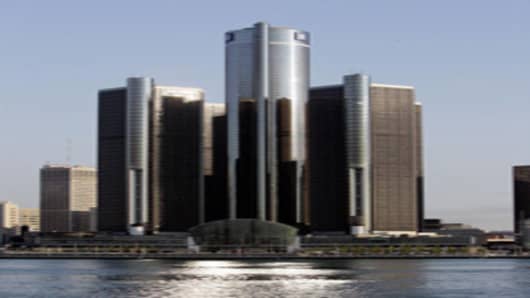Just over a month after a major restructuring, General Motors has made some more drastic cuts as questions continue to swirl around it about its liquidity.
"I think it's fair to say that conditions have worsened significantly in auto sales in the last couple of months," GM Chairman and CEO Richard Wagoner told CNBC, "and this mix shift away from trucks and SUVs to smaller vehicles has continued, and, frankly, the financial market conditions we think have gotten quite a bit worse over the last couple of months."
"So we decided we needed to move to take more of this funding into our own hands and not rely as much on market," he said. "We hope it's all we need to do, but, frankly, we have to watch and see how the economy and the market develops."
GM's latest plan calls for $10 billion in cost cuts, suspending the common stock dividend and selling as much as $4 billion in assets in a bid to shore up cash.
The hurried restructuring, the second in just the past six weeks, is driven by high fuel prices, a shift away from trucks and SUVs, and the weakest U.S. industrywide auto sales in a decade.
GM, which has lost $51 billion over the past three years as it cut jobs and closed plants, said the new steps were aimed at addressing deepening concerns that have driven its stock price to 54-year lows and raised the cost of insuring its debt against default.
"What we saw was an even decidedly more hostile environment in the capital markets," GM President and Chief Operating Officer Fritz Henderson told reporters. "You saw financial markets almost seize up."
The automaker said it would cut white-collar employment costs by 20 percent, a step expected to mean the loss of thousands of jobs among the 40,000 salaried workers GM employs in North America.
GM shares rose nearly 7 percent on the restructuring news but remain down 60 percent this year. Since Chief Executive Rick Wagoner took over in 2000, the shares have fallen more than 80 percent. (See the accompanying CNBC video interview with Rick Wagoner for more.)
Analysts said GM's plan, intended to raise $15 billion in liquidity through 2009, addressed the most urgent Wall Street concerns about pressure on its $24 billion in remaining cash.
But they also cautioned that the company's turnaround still hinged on a recovery in the U.S. economy and on GM's ability to sell more fuel-efficient passenger cars, a market now dominated by import brands led by Toyota Motor.
GM has faced criticism for restructuring steps since 2005 that have consistently fallen short of what was required given the downward spiral in its results.
"For now, this solves GM's liquidity issues, but we have to see better demand for automobiles, for cars and trucks, in order for the liquidity crisis to be put to bed," said Tim Ghriskey, chief investment officer at Solaris Asset Management in New York. "They're burning through about $3 billion in cash a quarter. The cash drain has to stop at some point or GM has larger problems."
GM said it would save $10 billion in cash through 2009 through a series of steps that will cut white-collar jobs, retiree health-care coverage and executive bonuses for 2008.
Capital spending will be cut by $1.5 billion, and GM will accelerate plant closures announced last month as it aims to move its vehicle line-up away from a reliance on light trucks.
Lehman Brothers analyst Brian Johnson called the cost-cutting targets "relatively credible" but said the overall plan fell short of a vision for renewal.
"The announcements offered little sense of a 'new' GM strategy or shift in the organizational culture that might set the stage for a more dramatic reinvention," he said in a note to clients.
Pressure, Stakes on the Rise
GM has been under intensifying pressure to cut costs and raise capital because of the slump in U.S. auto sales that drove its first-half sales down 16 percent.
In early June, Wagoner announced the company would close four North American truck plants employing about 10,000 workers and try to sell its Hummer brand in response to higher gas prices.
But market sentiment has darkened on GM and the auto sector in the weeks since that announcement, with most analysts no longer expecting a real recovery in U.S. auto sales in 2009.
Wagoner said GM's steps would provide it with ample liquidity through 2009, even assuming a continued weak U.S. market crimped by high oil prices.
GM said it had retained financial advisers to look at other asset sales expected to raise $2 billion to $4 billion by the end of 2009. Executives said potential buyers had already expressed interest in Hummer, but they gave no details.
GM also said it had set an initial target of raising $2 billion to $3 billion in new financing that could be secured by stock in its overseas subsidiaries, its auto brands, its stake in finance company GMAC and real estate.
Wagoner and other executives said GM could borrow significantly more if debt markets recovered.
GM will begin capturing savings from a cost-cutting deal with the United Auto Workers union in 2010. The company said the union had approved a deferral of $1.7 billion that had been scheduled for payment to a health care trust aligned with the UAW.
That deferred payment means GM's major union will be effectively loaning it money at 9 percent interest until the deferred payments to the health care account are made.


